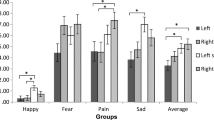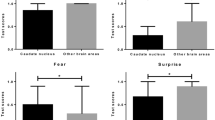Abstract
The superior temporal gyrus (STG) has been found to play a crucial role in the recognition of actions and facial expressions and may, therefore, be critical for the processing of humorous information. Here we investigated whether tDCS application to the STG would modulate the ability to recognize and appreciate the comic element in serious and comedic situations of misfortune. To this aim, the effects of different types of tDCS stimulation on the STG were analyzed during a task in which the participants were instructed to categorize various misfortunate situations as “comic” or “not comic”. Participants underwent three different tDCS conditions: Anodal-right/Cathodal-left; Cathodal-right/Anodal-left; Sham. Images depicting people involved in accidents were grouped into three categories based on the facial expression of the victim: angry or painful (Affective); bewildered and funny (Comic); and images that did not contain the victim’s face (No Face). An improvement in mean reaction times in response to both the Comic and No Face stimuli was observed following Anodal-left/Cathodal-right stimulation when compared to sham stimulation. This suggests that this stimulation type reduced the reaction times to socio-emotional complex scenes, regardless of facial expression. The Anodal-right/Cathodal-left stimulation reduced the mean reaction times for Comic stimuli only, suggesting that specifically the right STG may be involved in facial expression recognition and in the appreciation of the comic element in misfortunate situations. These results suggest a functional hemispheric asymmetry in STG response to social stimuli: the left STG might have a role in a general comprehension of social complex situations, while the right STG may be involved in the ability to recognize and integrate specific emotional aspects in a complex scene.




Similar content being viewed by others
References
Adolphs R (2002) Neural systems for recognizing emotion. Curr Opin Neurobiol 12(2):169–177
Allison T, Puce A, Mccarthy G (2000) Social perception from visual cues: role of the STS region. Trends Cogn Sci 4(7):267–278
Andrews TJ, Ewbank MP (2004) Distinct representations for facial identity and changeable aspects of faces in the human temporal lobe. NeuroImage 23(3):905–913
Bartolo A, Benuzzi F, Nocetti L, Baraldi P, Nichelli P (2006) Humor comprehension and appreciation: an FMRI study. J Cogn Neurosci 18(11):1789–1798
Beyer F, Münte TF, Krämer UM (2013) Increased neural reactivity to socio-emotional stimuli links social exclusion and aggression. Biol Psychol 96:102–110
Boggio PS, Rocha RR, da Silva MT, Fregni F (2008) Differential modulatory effects of transcranial direct current stimulation on a facial expression go-no-go task in males and females. Neurosci Lett 447(2–3):101–105
Bolognini N, Rossetti A, Casati C, Mancini F, Vallar G (2011) Neuromodulation of multisensory perception: a tDCS study of the sound-induced flash illusion. Neuropsychologia 49(2):231–237
Bonda E, Ostry D, Evans A (1996a) Specific Involvement of human parietal systems in the perception of biological motion and the amygdala. J Neurosci 76(11):3737–3744
Bonda E, Petrides M, Ostry D, Evans A (1996b) Specific involvement of human parietal systems and the amygdala in the perception of biological motion. J Neurosci 16:3737–3744
Boorstin (1990). Making movies work: thinking like a filmmaker. Silman-James Press, Beverley Hills
Bruce V (1983) Recognizing faces. Philos Trans R Soc Lond Ser B 302:423–436
Bruce V, Valentine T (1986) Semantic priming of familiar faces. Q J Exp Psychol Sect A 38(1): 125–150
Bruce V, Young A (1986) Understanding face recognition. Br J Psychol 77:305–327
Bruce V, Young A (1998) The science of face perception. Oxford University Press, New York. In the eye of the beholder: the science of face perception.
Brunet E, Sarfati Y, Hardy-Bayle MC, Decety J (2000) A PET investigation of the attribution of intentions with a nonverbal task. NeuroImage 11:157–166
Brunoni AR, Amadera J, Berbel B, Volz MS, Rizzerio BG, Fregni F (2011) A systematic review on reporting and assessment of adverse effects associated with transcranial direct current stimulation. Int J Neuropsychopharmacol 14(8):1133–1145
Buxbaum LJ, Kalénine S (2010) Action knowledge, visuomotor activation, and embodiment in the two action systems. Ann N Y Acad Sci 1191:201–218
Calder AJ, Young AW (2005) Understanding the recognition of facial identity and facial expression. Nat Rev Neurosci 6(8):641–651
Candidi M, Stienen BMC, Aglioti SM, De Gelder (2015) Virtual lesion of right posterior superior temporal sulcus modulates conscious visual perception of fearful expressions in faces and bodies. Cortex 65:184–194
Decety J, Grèzes J (1999) Neural mechanisms subserving the perception of human actions. Trends Cogn Sci 3(5):172–178
Decety J, Grezes J, Costes N, Perani D et al (1997) Brain activity during observation of actions. Influence of action content and subject’s strategy. Brain 120:1763–1777
Engell AD, Haxby JV (2007) Facial expression and gaze-direction in human superior temporal sulcus. Neuropsychologia 45(14):3234–3241
Franklin RG Jr, Adams RB Jr (2011) The reward of a good joke: neural correlates of viewing dynamic displays of stand-up comedy. Cogn Affect Behav Neurosci 11(4):508–515
Fregni F, Boggio PS, Nitsche M, Bermpohl F, Antal A, Feredoes E et al (2005) Anodal transcranial direct current stimulation of prefrontal cortex enhances working memory. Exp Brain Res 166:23–30
Goel V, Dolan RJ (2001) The functional anatomy of humor: segregating cognitive and affective components. Nat Neurosci 4(3):237–238
Haxby JV, Hoffman EA, Gobbini MI (2000) The distributed human neural system for face perception. Trends Cogn Sci 4(6):223–233
Herwig U, Satrapi P, Schönfeldt-Lecuona C (2003) Using the international 10–20 EEG system for positioning of transcranial magnetic stimulation. Brain Topogr 16:95–99
Hinojosa JA, Mercado F, Carretié L (2015) N170 sensitivity to facial expression: a meta-analysis. Neurosci Biobehav Rev 55:498–509
Horstmann G, Bauland A (2006) Search asymmetries with real faces: testing the anger-superiority effect. Emotion 6(2):193–207
Hurley MM, Dennett D, Adams RG (2011) Inside jokes: using humor to reverse-engineer the mind. The MIT Press, Cambridge, MA
Ishai A (2008) Let’s face it: it’s a cortical network. NeuroImage 40(2): 415–419
Jeong JW, Diwadkar VA, Chugani CD, Sinsoongsud P, Muzik O, Behen ME, Chugani DC (2011) Congruence of happy and sad emotion in music and faces modifies cortical audiovisual activation. NeuroImage 54(4): 2973–2782
Koenigsberg HW, Fan J, Ochsner KN, Liu X, Guise K, Pizzarello S, Siever LJ (2010) Neural correlates of using distancing to regulate emotional responses to social situations. Neuropsychologia 48(6):1813–1822
Kohn N, Kellermann T, Gur RC, Schneider F, Habel U (2011) Gender differences in the neural correlates of humor processing: implications for different processing modes. Neuropsychologia 49(5):888–897
Kutas M, Federmeier KD (2011) Thirty years and counting: finding meaning in the N400 component of the event-related brain potential (ERP). Annu Rev Psychol 62:621–647
Labar KS, Crupain MJ, Voyvodic JT (2003) Dynamic perception of facial affect and identity in the human brain. Cereb Cortex 13:1023–1033
Lavan N, Lima CF (2014) Neurocognitive mechanisms for vocal emotions: sounds, meaning, action. J Neurosci Off J Soc Neurosci 34(39):12950–12952
Luck SJ, Kappenman ES (2012). Oxford handbook of event-related potential components. Oxford University Press, New York
Manfredi M, Adorni R, Proverbio AM (2014) Why do we laugh at misfortunes? An electrophysiological exploration of comic situation processing. Neuropsychologia 61:324–334
Marinkovic K, Baldwin S, Courtney MG, Witzel T, Dale AM, Halgren E (2011) Right hemisphere has the last laugh: neural dynamics of joke appreciation. Cogn Affect Behav Neurosci 11(1), 113–130
Marques LM, Lapenta OM, Merabet LB, Bolognini N, Boggio PS (2014) Tuning and disrupting the brain-modulating the McGurk illusion with electrical stimulation. Front Hum Neurosci 8:533
Mobbs D, Greicius MD, Abdel-Azim E, Menon V, Reiss AL (2003) Humor modulates the mesolimbic reward centers. Neuron 40(5):1041–1048
Narumoto J, Okada T, Sadato N, Fukui K, Yonekura Y (2001) Attention to emotion modulates fMRI activity in human right superior temporal sulcus. Cogn Brain Res 12:225–231
Neely MN, Walter E, Black JM, Reiss AL (2012) Neural correlates of humor detection and appreciation in children. J Neurosci Off J Soc Neurosci 32(5):1784–1790
Nitsche MA, Liebetanz D, Antal A, Lang N, Tergau F, Paulus W (2003a) Modulation of cortical excitability by weak direct current stimulation technical, safety and functional aspects. Suppl Clin Neurophysiol 56:255–276
Öhman A, Lundqvist D, Esteves F (2001) The face in the crowd revisited: a threat advantage with schematic stimuli. J Pers Soc Psychol 80:381–396
Oldfield RC (1971). The assessment and analysis of handedness: the Edinburgh inventory. Neuropsychololgia 9:97–113
Pessoa L, Padmala S (2007) Decoding near-threshold perception of fear from distributed single-trial brain activation. Cerebral cortex 17(3):691–701
Pinkham AE, Griffin M, Baron R, Sasson NJ, Gur RC (2010) The face in the crowd effect: anger superiority when using real faces and multiple identities. Emotion 10(1):141–146
Pitcher D (2014) Facial expression recognition takes longer in the posterior superior temporal sulcus than in the occipital face area. J Neurosci 34:9173–9177
Pitcher D, Garrido L, Walsh L, Duchaine BC (2008) Transcranial magnetic stimulation disrupts the perception and embodiment of facial expressions. J Neurosci 28(36):8929–8933
Proverbio AM, Riva F, Zani A (2010) When neurons do not mirror the agent’s intentions: sex differences in neural coding of goal-directed actions. Neuropsychologia 48(5):1454–1463
Proverbio AM, Paganelli L, Cappa SF, Canessa N, Perani D, Zani A (2011) Neural coding of cooperative vs. affective human interactions: 150 ms to code the action’s purpose. PLoS One 6(7):e22026
Proverbio AM, Crotti N, Manfredi M, Adorni R (2012) Who needs a referee? How incorrect basketball actions are automatically detected by basketball players’ brain. ScientificReports (Nature), 2: 883
Proverbio AM, Calbi M, Manfredi M, Zani A (2014) Comprehending body language and mimics: an ERP and neuroimaging study on Italian actors and viewers. PLoS One 9(3):e91294
Ratner C (1989) A social constructionist critique of naturalistic theories of emotion. J Mind Behav 10:211–230
Samson D, Apperly, a I, Chiavarino C, Humphreys GW (2008) Cognitive humor processing: different logical mechanisms in nonverbal cartoons—an fMRI study. Soc Neurosci 3(2):125–140
Samson AC, Hempelmann CF, Huber O, Zysset S (2009) Neural substrates of incongruity-resolution and nonsense humor. Neuropsychologia 47:1023–1033
Stein J (ed) (2002) The Random House Dictionary of the English Language: the Unabridged Edition, 2 Revised edition
Suls JM (1972) A two-stage model for the appreciation of jokes and cartoons. In: Goldstein PE, McGhee JH (eds) The psychology of humour. Theoretical perspectives and empirical issues. Academic Press, New York, pp 81–100
Talairach J, Tournoux P (1988) Co-planar stereotactic atlas of the human brain. Thieme Verlag, Stuttgart
Vander Wyk BC, Hudac CM, Carter EJ, Sobel DM, Pelphrey KA (2016) Action Understanding in the superior temporal sulcus region. Psychol Sci 20(6):771–777
Vrticka P, Black JM, Reiss AL (2013) The neural basis of humour processing. Nat Rev Neurosci 14(12):860–868
Wallbott HG (1988) In and out of context: influences of facial expression and context information on emotion attributions. Br J Soc Psychol 27:357–369
Watson KK, Matthews BJ, Allman JM (2007) Brain activation during sight gags and language-dependent humor. Cereb Cortex 17(2):314–324
Winston JS, Henson RNA, Dolan RJ (2004) fMRI-adaptation reveals dissociable neural representations of identity and expression in face perception. J Neurophysiol 92:1830–1839
Zhang H, Japee S, Nolan R, Chu C, Liu N, Ungerleider LG (2016) NeuroImage Face-selective regions differ in their ability to classify facial expression. NeuroImage 130:77–90
Acknowledgements
Paulo S. Boggio is supported by a CNPq research Grant (311641/2015-6). Mirella Manfredi is supported by a FAPESP post-doctoral researcher Grant (2015/00553-5).
Author information
Authors and Affiliations
Corresponding author
Additional information
An erratum to this article is available at http://dx.doi.org/10.1007/s00221-017-4974-8.
Rights and permissions
About this article
Cite this article
Manfredi, M., Proverbio, A.M., Gonçalves Donate, A.P. et al. tDCS application over the STG improves the ability to recognize and appreciate elements involved in humor processing. Exp Brain Res 235, 1843–1852 (2017). https://doi.org/10.1007/s00221-017-4932-5
Received:
Accepted:
Published:
Issue Date:
DOI: https://doi.org/10.1007/s00221-017-4932-5




